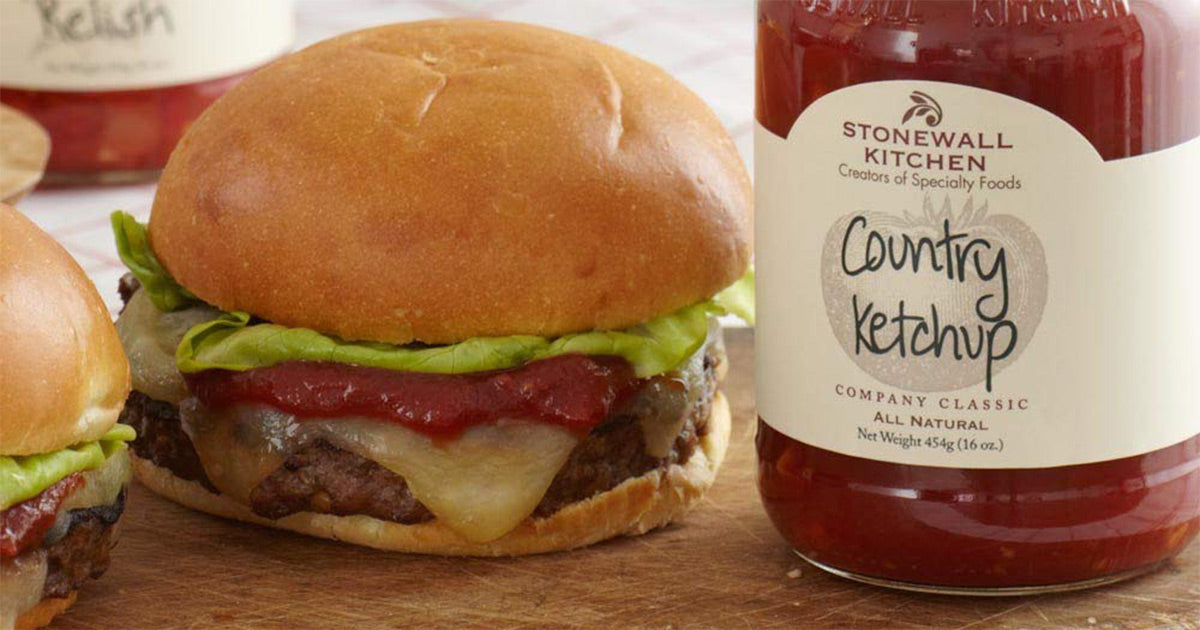
Yes, you read that right.
But before you get all scared and look for the ketchup bottle in the refrigerator, here is a quick all-clear. Your standard ketchup from the supermarket around the corner almost certainly contains, depending on the manufacturer, at least traces of tomatoes .
But that wasn't always the case.
Fishy Origins
Even though the origins of ketchup go back to the Time before Christ and it is still not entirely clear where the sauce originated, we do know one thing for sure:
Ketchup was initially pure nothing to do with tomatoes to do.
Early researches sought the origin of the sauce in Far East . Already in the 19th century, it was assumed that the term ketchup was derived from Malaysian. A look into a Malaysian dictionary, however, reveals that the term is also only a derivation, namely from the Chinese .
In fact, in a special Chinese dialect, you can find the word kê-tsiap, which means a thick sauce made of fermented fish The key point of this derivation, however, is that according to linguists, this word is also only an import into the Chinese language, with a probable origin in Vietnam .
But how do you get from fish sauce to today's tomato ketchup?
Contrary to all etymology, the most likely origin story for one of the world's most popular sauces lies in Southeast Asia, more precisely in Indonesia . Here, under the word “kecap”, a sauce based on black soybeans manufactured.
Even if the exact origins of the sauce, which is now popular around the world, are not known, Western knowledge of the term has been 17th century verifiable, as English merchants brought the sauce from Southeast Asia. In the following decades, a number of sometimes very different sauces developed under the name ketchup. These recipes were mostly based on Oysters, mushrooms, walnuts or beetroot and were more like thick pastes that were diluted with other liquids depending on use and preference.
Already from Mid-18th century Such ketchup was used as Ready-made sauce sold in shops, not just produced as a family recipe for consumption in the home kitchen.
In many cases, all these variations of the sauce brought from Asia had only one thing in common:
Tomatoes were searched for in vain.
Even though most people today equate ketchup with tomatoes without much questioning, these early European experiments and their, until recently, tomato-free, Thousands of years of history of the sauce. For this reason, you can still find the clear print on the bottles of Heinz, Hela & Co. “Tomato ketchup” as a differentiation from other, today hardly known forms of sauce.
The tomato
Although the original from South America tomatoes from since the 16th century known in Europe, but at that time no one would have thought of eating the fleshy fruits, let alone using them as a base for sauces. Tomatoes belong to the genus Solanaceae , a group of plants popularly known for their Toxicity In fact, tomatoes, as well as potatoes, tobacco and deadly nightshade, actually contain the The slightly toxic substance solanine . This substance is heat-resistant, meaning it is not broken down during cooking or frying. It can be fatal to humans at concentrations of approximately 400 milligrams and as little as 25 milligrams can lead to health problems and symptoms of poisoning.
But Don’t panic : the material can be found only in certain parts of the plant and even then only at certain times of the ripening cycle . As a simplified rule of thumb: if the tomato has green spots, they contain solanine.
For ripe tomatoes, the values to be neglected The actual amount of toxin contained in unripe parts of the fruit can still vary greatly. Completely green tomatoes, for example, contain between 9 and 32 milligrams of toxin per 100g of fruit.
Historically, the tomato's main problem was that its relationship to other nightshade plants such as the potato was recognized early on. The potato Like the tomato, it was initially grown mainly kept as an ornamental plant and was considered poisonous because people did not know how to prepare the tubers properly. In Germany, it only Frederick II of Prussia In 1740, he attempted to break the farmers' caution when he had potato fields planted in Berlin and "guarded" by soldiers. The apparent value of the plants then enticed the farmers to to steal from the fields and ultimately to cultivate it on a large scale – entirely in keeping with the ruler’s wishes.
Unlike the potato, the tomato, with enough time, literally made it into popular culture without such tricks. the Italians , who in the 17th and 18th centuries began to cultivate the fruit of the rare ornamental plant as medicine to use. From 1719 onwards, it can be proven that Italians ate tomatoes, and by the end of the 18th century, the rest of Europe had also overcome their fear of tomatoes.
The tomato sauce was not long in coming and the first recipe for “ketchup” based on pureed tomatoes was seen 1812 in England the face of the world. What distinguished it from the usual sauces was, above all, the Addition of vinegar which caused the sauce to ferment and keep for a long time. “Tomato ketchup” was born .
From Zero to Hero
But even if the initial hesitancy had vanished, there was still a long way to go for tomato ketchup to reach the undisputed position of world's most popular seasoning sauce and some milestones along the way were surprisingly curious.
As already mentioned, at the time of the first ketchup, there were already many other sauces under the same label, which were already produced and distributed on a large scale (for the time). Ketchup, on the other hand, had become widespread, especially in the USA, by the middle of the 19th century, but at that time it was still mainly homemade. made at home .
As is so often the case, efficiency brought about the upheaval. When canned tomatoes began to be produced industrially on a large scale in the mid-19th century, as expected, a by-product crushed tomatoes – also known as the basis of ketchup. Instead of throwing it away, many manufacturers came up with the idea of collecting the waste product and producing the popular tomato ketchup on a large scale, selling it for additional profit – with success.
One of these ketchup pioneers was the company Heinz , who already managed to become undisputed market leader in the USA. By 1905, production at Heinz alone amounted to 5 million ketchup bottles in the year.
Henry John Heinz was so convinced of the quality of his sauce that he spent his free time wandering around bars and pubs looking for ketchup bottles from his house. When he found them, he bought the bottle from the innkeeper and took them with him in the belief that the presence of his products in such establishments would damage his brand.
While ketchup consumption boomed in the USA in the 1900s, at the beginning of the century it was hardly widespread in Germany and only through Import from abroad available in specialty stores. We owe the first German ketchup to today's food manufacturer Zeisner , who began production in Bremen in 1937. Due to World War II and the poverty of the post-war period, ketchup remained a Rarity in German kitchens , but the influence of stationed American and British soldiers soon made tomato ketchup tasty for the people here too and so it did not take long until the ketchup was combined with a typical German dish - the Currywurst .
From 1954 onwards, starting with Kraft , more and more ketchup producers, especially from the USA, on the West German market and take advantage of the ever-increasing demand in the 1960s.
Also in the GDR Ketchup gained popularity and quickly became part of the so-called “Buck goods” – goods that were not always available for purchase and were primarily traded under the table. Contrary to the trend in the USA, many East Germans oriented themselves away from factory-made goods. Back to home production . A large portion of the tomatoes eaten in the GDR came from citizens' own gardens anyway.
The first widely used commercial DDR ketchup was from the Werder company and enjoyed great popularity, especially in East Germany but also in neighboring countries of the Eastern Bloc. Even today, there is lively nostalgia and the Try to imitate the old recipe are diverse.
While in both parts of Germany ketchup is primarily a Luxury goods the situation on the other side of the Atlantic was quite different at the same time. There, ketchup had quickly spread to the lowest income brackets due to the large number of producers. Affordability of the spice sauce from tomatoes was such an important factor that even the policy tried to use it for his own benefit. In 1981, under the government of President Reagan , the Department of Health and Human Services was tasked with the difficult task of reducing the costs of daily meals in school cafeterias The solution: ketchup. A new law was introduced in an expedited procedure that makes the affordable condiment officially declared as vegetables Thus, adding ketchup would have covered a large portion of the vegetables required by law in every school lunch. However, this law never made it beyond a draft and was quickly rejected by the opposition. The children were allowed to continue eating vegetables.
With constant growing international demand After the end of World War II and the Cold War, ketchup soon earned the title of world's most popular spice sauce secured and for a long time it looked as if nothing could ever end this triumph.
In 2020, however, the king of spiced sauces suffered a severe blow.
In connection with the global corona crisis In the USA, still one of the main consumers, there was a Ketchup shortage . Consumers were forced to rethink and soon found their new favorite: Mayonnaise .
Whether this trend is merely circumstantial or reflects a long-term shift in consumer thinking remains to be seen.
In principle, ketchup in the USA and Europe is now divided into three special variants: tomato ketchup, spice ketchup and curry ketchup.
Tomato ketchup is probably the most well-known variant internationally and also fills around 70% of all ketchup bottles. What distinguishes it is the high Percentage of tomatoes used , which after pureeing are only mixed with vinegar, sugar, garlic, onions and other spices and thickeners.
What the Spiced ketchup What distinguishes it from classic tomato ketchup is the addition of other flavors, such as cucumbers, peppers, or chili peppers, which replace some of the tomato paste used. These include related tomato-based sauces such as e.g. steak and barbecue sauces .
Curry ketchup is particularly popular in Germany and accounts for 20% of ketchup consumption. commercially available tomato ketchup , which is made with appropriate Curry spice mixes is enriched.
In addition to the well-known recipes, there are still some exotic oddities , e.g. Indonesian banana ketchup . The production and recipes are largely identical to the normal tomato ketchup, only the Tomatoes replaced with bananas .
Also recipes for Pumpkin ketchup , based on the same principle, is very popular.
Also Green ketchup is becoming more and more popular and in demand. But don't worry, the ketchup is not from green tomatoes and therefore does not contain solanine. Instead, Spinach and green peppers the contrasting color for this type of popular sauce.
In the early 2000s Heinz came up with the idea of producing ketchup in other colors, but only used the traditional tomato ketchup and healthy Food coloring . The result was colors like green, violet, pink, orange, and blue.
Tomato ketchup is enjoying great popularity and new alternatives to traditional tomato paste are constantly trying to compete with the classic. original European recipes based on mussels, fish, etc. have completely disappeared from most people's everyday lives.
From Hero to Zero (Zucker)
What is striking is that all these recipes, in addition to their vegetable base and the vinegar for fermentation and preservation, have one other ingredient in common: Sugar .
As is often the case, sugar in ketchup has two main functions, namely to enhance taste and by the way the mass of the final product , which means that you need fewer other ingredients per bottle than without the addition of sugar. And this proportion can sometimes be quite significant. In traditional ketchup from the USA, for example, you can find up to 24 grams of sugar per 100 milliliters Ketchup and even in commercial brands with significantly less sugar, the proportion is usually well above the 10% mark .
To clarify: A standard sugar cube contains approximately 3 g of sugar.
If you want to enjoy your ketchup with significantly less sugar, it is best to turn to foreign producers as a German. Country Ketchup from Stonewall Kitchen from Maine, for example, contains 517 grams of ketchup just 27 grams of sugar, so only 5% . But this makes absolutely no difference to the taste experience.

If you like your ketchup completely sugar-free enjoy, there is often no other option than to make the ketchup yourself like in the good old days. A popular Alternative to refined sugar is the mixing of sweet fruits such as pureed Dates or Apricots , which still give the ketchup its typical fruity-sweet note. Honey is a popular natural alternative.
Theoretically, homemade ketchup can also be completely without sugar or the addition of other sweeteners by simply adjusting the proportion with more tomato paste However, traditional tomato ketchup then loses its distinctive sweet note.
Miracle cure ketchup
Even though everyone knows ketchup as a delicious accompaniment to fries and the like, the red sauce also has a whole host of interesting and helpful properties that often go unnoticed.
An example from everyday life:
Who hasn't struggled to get ketchup out of the bottle? The miracle cure is often called Tap or shake the bottle . Ketchup is a so-called “Non-Newtonian fluid” . This strange-sounding name simply means that ketchup is a liquid that viscosity changes under pressure or tension, unlike water, for example. If the ketchup remains still and unmoved in the bottle for a long time, it becomes thick and viscous and can sometimes be almost impossible to get out of the bottle without the help of utensils. By tapping or shaking, the ketchup is subjected to tension that thinner and thus makes it easier to run out of the bottle.
By the way, ketchup is not the only substance with this property and the same behavior can be found in toothpaste, honey, melted butter, shampoo, blood, quicksand and granules, among others.
Far from physics, ketchup also has some surprising Applications in everyday life and is becoming a kind of Swiss Army knife of spice sauces.
Perhaps the most well-known extra ability of ketchup is that it is able to To neutralize odors . In film and television, it is often used for slapstick when people bathtub full of ketchup to get involved Skunk smell A much more practical application for this ability, at least in this country, is the Pet care . Give your four-legged friend a ketchup treatment instead of shampoo, and the annoying odor will disappear in no time.
And if you don’t just want to use the sauce for eating, you should Cleaning dishes also reach for the ketchup bottle – at least if you have pots and pans made of copper used. The substance contained in ketchup acid is perfect for removing dirt from copper objects, but for the same reason as cola, it also works for cleaning Jewelry , removing Water stains from sink & co. or even the Car wash .
Let us return to the Hair care .
Who doesn't like to go swimming in the summer? Unfortunately, that can be difficult, at least if you blonde hair can quickly become a problem and before you know it, the golden hair is suddenly green . The reason for this, so it is popularly said, is chlorine – at least partially. Chlorine itself does not discolor the hair. The green color comes from copper, which Pool water Chlorine, together with water, ensures that Copper oxidizes and takes on the typical green color. This copper then binds to the hair proteins. This happens to everyone, but is much less noticeable with darker shades. But that doesn't mean you have to miss out on the pool if you have light hair. Simply while showering ketchup like usual conditioner Massage into hair and rinse. Just like with cooking utensils, the acid in the ketchup dissolves the copper particles and thus the green color from the hair.
In some rural areas Eastern Europe Ketchup-like pastes and purees made from tomatoes and ketchup are sometimes still used today as traditional preservatives used. The pastes contain Vinegar Like normal ketchup, it acts as a preservative and food that is immersed and stored in these pastes also directly benefit from this effect.
As you can see, ketchup is a A true all-rounder . So feel free to pick up an extra bottle or glass next time you go shopping. The possibilities are endless.


